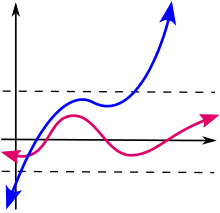Bounded Continuous Functions Form Complete Space

A schematic illustration of a bounded function (red) and an unbounded one (blue). Intuitively, the graph of a bounded function stays within a horizontal band, while the graph of an unbounded function does not.
In mathematics, a function f defined on some set X with real or complex values is called bounded if the set of its values is bounded. In other words, there exists a real number M such that
for all x in X.[1] A function that is not bounded is said to be unbounded.[ citation needed ]
If f is real-valued and f(x) ≤ A for all x in X, then the function is said to be bounded (from) above by A. If f(x) ≥ B for all x in X, then the function is said to be bounded (from) below by B. A real-valued function is bounded if and only if it is bounded from above and below.[1] [ additional citation(s) needed ]
An important special case is a bounded sequence, where X is taken to be the set N of natural numbers. Thus a sequence f = (a 0, a 1, a 2, ...) is bounded if there exists a real number M such that
for every natural number n. The set of all bounded sequences forms the sequence space .[ citation needed ]
The definition of boundedness can be generalized to functions f : X → Y taking values in a more general space Y by requiring that the image f(X) is a bounded set in Y.[ citation needed ]
[edit]
Weaker than boundedness is local boundedness. A family of bounded functions may be uniformly bounded.
A bounded operator T : X → Y is not a bounded function in the sense of this page's definition (unless T = 0), but has the weaker property of preserving boundedness: Bounded sets M ⊆ X are mapped to bounded sets T(M) ⊆ Y. This definition can be extended to any function f : X → Y if X and Y allow for the concept of a bounded set. Boundedness can also be determined by looking at a graph.[ citation needed ]
Examples [edit]
- The sine function sin : R → R is bounded since for all .[1] [2]
- The function , defined for all real x except for −1 and 1, is unbounded. As x approaches −1 or 1, the values of this function get larger in magnitude. This function can be made bounded if one restricts its domain to be, for example, [2, ∞) or (−∞, −2].[ citation needed ]
- The function , defined for all real x, is bounded, since for all x.[ citation needed ]
- The inverse trigonometric function arctangent defined as: y = arctan(x) or x = tan(y) is increasing for all real numbers x and bounded with − π / 2 < y < π / 2 radians[3]
- By the boundedness theorem, every continuous function on a closed interval, such as f : [0, 1] → R, is bounded.[4] More generally, any continuous function from a compact space into a metric space is bounded.[ citation needed ]
- All complex-valued functions f : C → C which are entire are either unbounded or constant as a consequence of Liouville's theorem.[5] In particular, the complex sin : C → C must be unbounded since it is entire.[ citation needed ]
- The function f which takes the value 0 for x rational number and 1 for x irrational number (cf. Dirichlet function) is bounded. Thus, a function does not need to be "nice" in order to be bounded. The set of all bounded functions defined on [0, 1] is much larger than the set of continuous functions on that interval.[ citation needed ] Moreover, continuous functions need not be bounded; for example, the functions and defined by and are both continuous, but neither is bounded.[6] (However, a continuous function must be bounded if its domain is both closed and bounded.[6])
See also [edit]
- Bounded set
- Compact support
- Local boundedness
- Uniform boundedness
References [edit]
- ^ a b c Jeffrey, Alan (1996-06-13). Mathematics for Engineers and Scientists, 5th Edition. CRC Press. ISBN978-0-412-62150-5.
- ^ "The Sine and Cosine Functions" (PDF). math.dartmouth.edu. Archived (PDF) from the original on 2 February 2013. Retrieved 1 September 2021.
- ^ Polyanin, Andrei D.; Chernoutsan, Alexei (2010-10-18). A Concise Handbook of Mathematics, Physics, and Engineering Sciences. CRC Press. ISBN978-1-4398-0640-1.
- ^ Weisstein, Eric W. "Extreme Value Theorem". mathworld.wolfram.com . Retrieved 2021-09-01 .
- ^ "Liouville theorems - Encyclopedia of Mathematics". encyclopediaofmath.org . Retrieved 2021-09-01 .
- ^ a b Ghorpade, Sudhir R.; Limaye, Balmohan V. (2010-03-20). A Course in Multivariable Calculus and Analysis. Springer Science & Business Media. p. 56. ISBN978-1-4419-1621-1.
Source: https://en.wikipedia.org/wiki/Bounded_function












0 Response to "Bounded Continuous Functions Form Complete Space"
Post a Comment